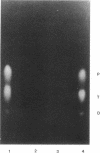Abstract
Many isolates of the Aeromonas species produce amonabactin, a phenolate siderophore containing 2,3-dihydroxybenzoic acid (2,3-DHB). An amonabactin biosynthetic gene (amoA) was identified (in a Sau3A1 gene library of Aeromonas hydrophila 495A2 chromosomal DNA) by its complementation of the requirement of Escherichia coli SAB11 for exogenous 2,3-DHB to support siderophore (enterobactin) synthesis. The gene amoA was subcloned as a SalI-HindIII 3.4-kb DNA fragment into pSUP202, and the complete nucleotide sequence of amoA was determined. A putative iron-regulatory sequence resembling the Fur repressor protein-binding site overlapped a possible promoter region. A translational reading frame, beginning with valine and encoding 396 amino acids, was open for 1,188 bp. The C-terminal portion of the deduced amino acid sequence showed 58% identity and 79% similarity with the E. coli EntC protein (isochorismate synthetase), the first enzyme in the E. coli 2,3-DHB biosynthetic pathway, suggesting that amoA probably encodes a step in 2,3-DHB biosynthesis and is the A. hydrophila equivalent of the E. coli entC gene. An isogenic amonabactin-negative mutant, A. hydrophila SB22, was isolated after marker exchange mutagenesis with Tn5-inactivated amoA (amoA::Tn5). The mutant excreted neither 2,3-DHB nor amonabactin, was more sensitive than the wild-type to growth inhibition by iron restriction, and used amonabactin to overcome iron starvation.
Full text
PDF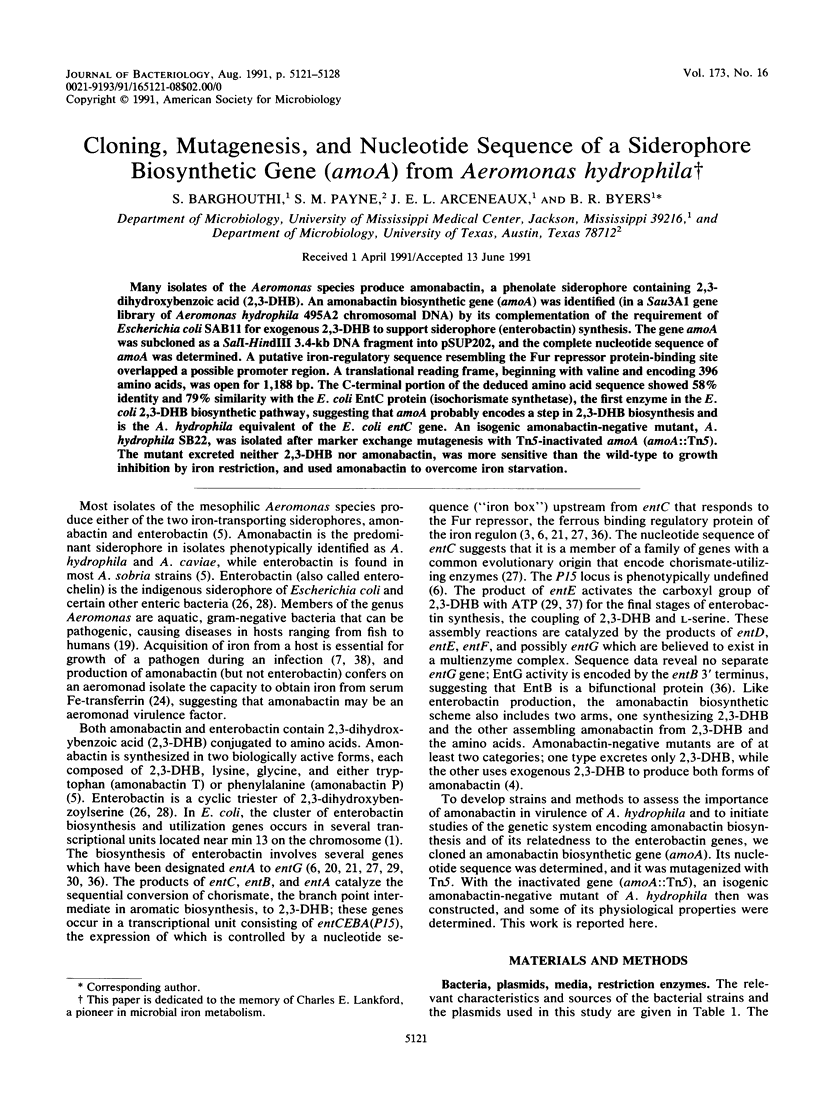
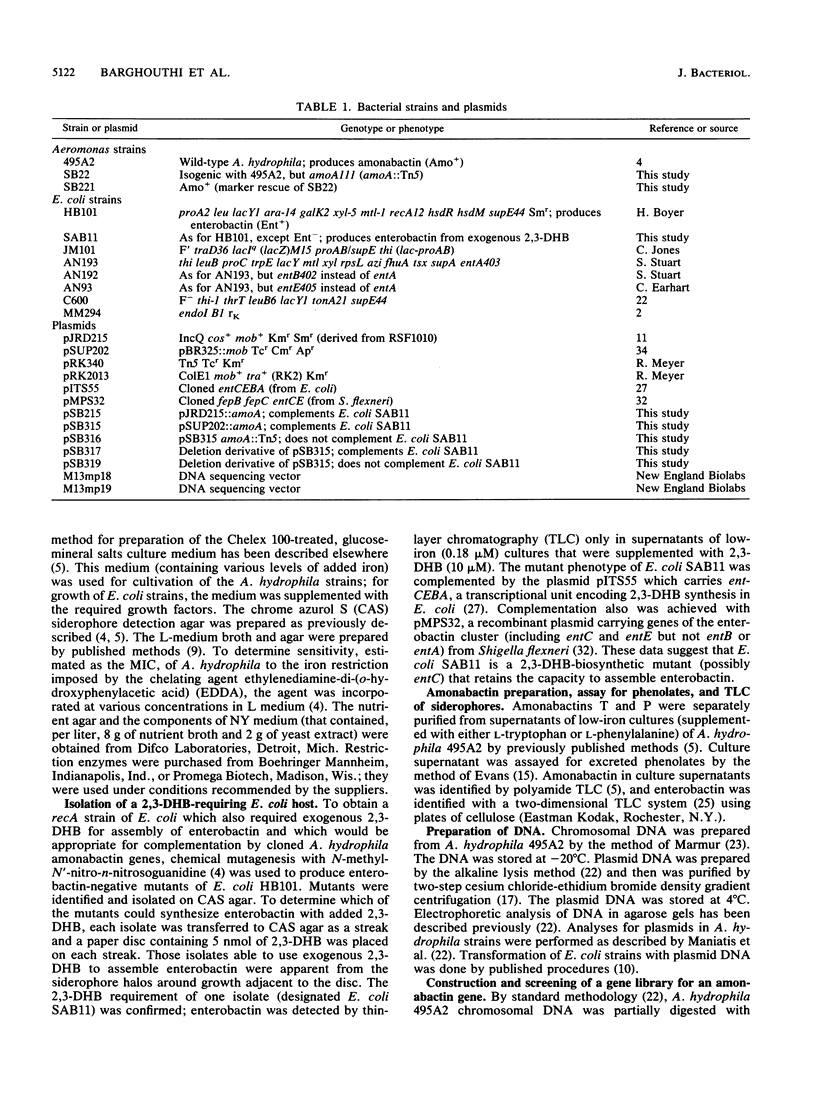
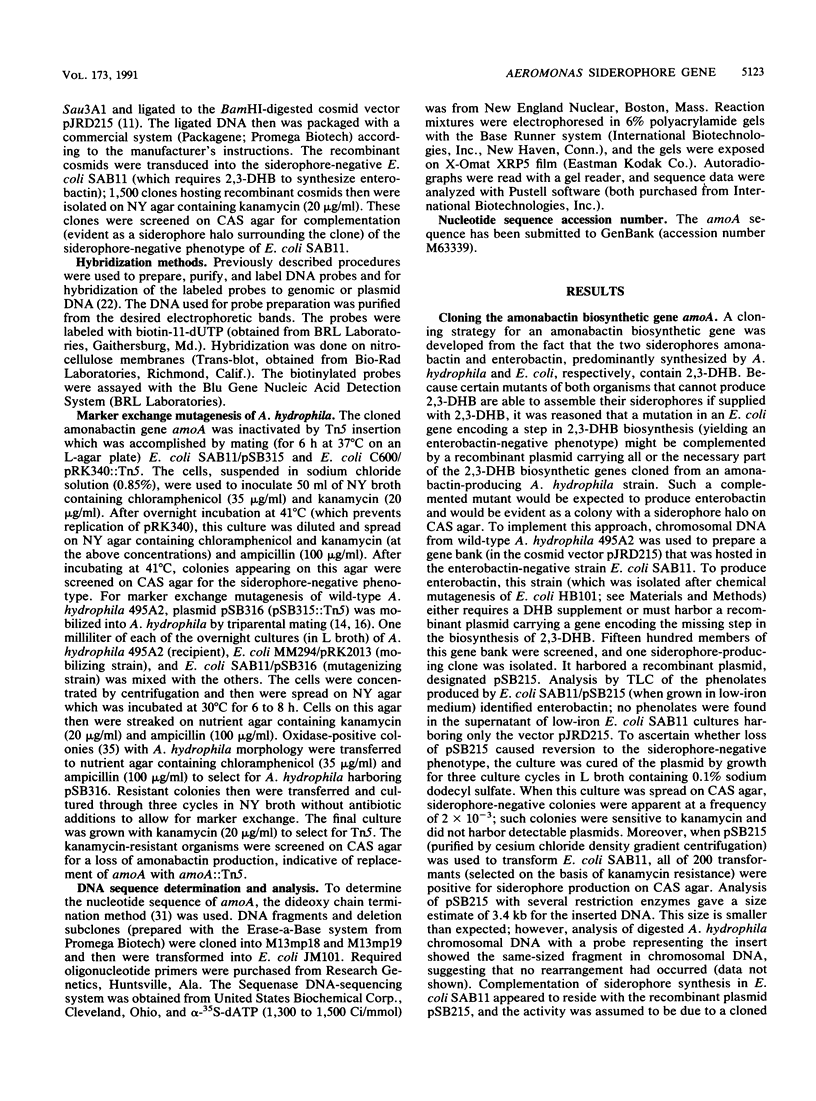
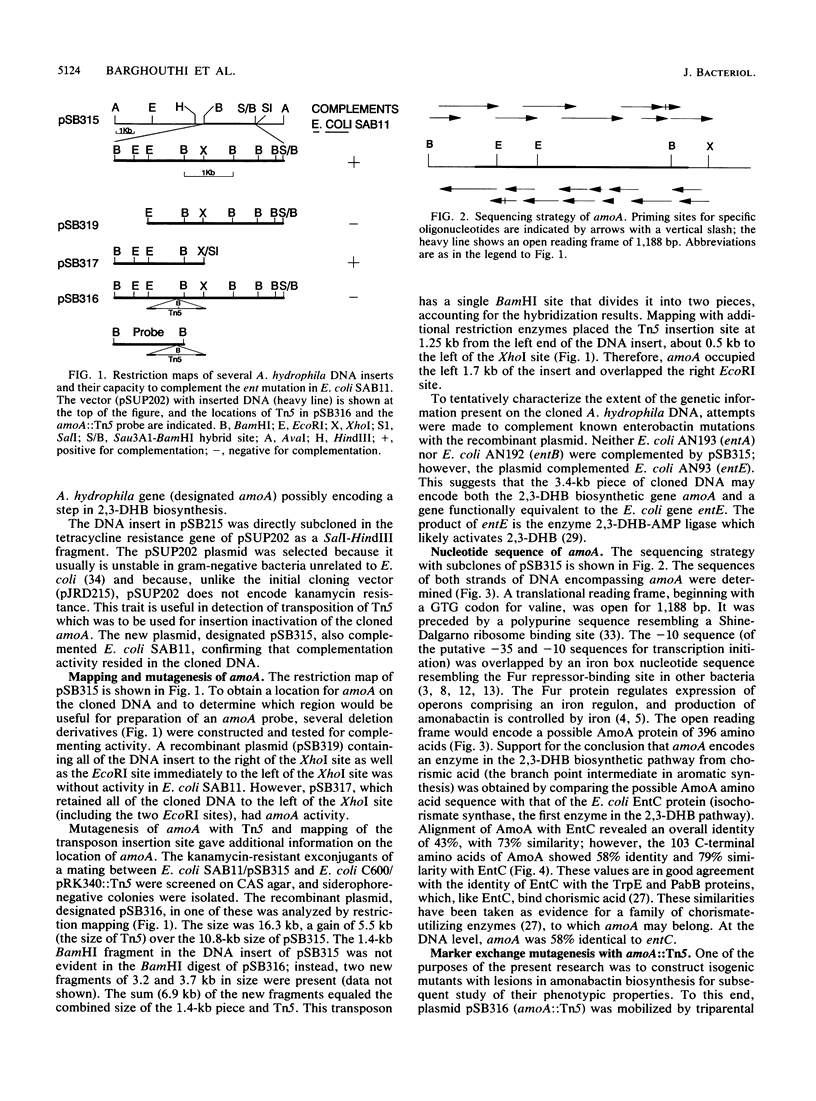
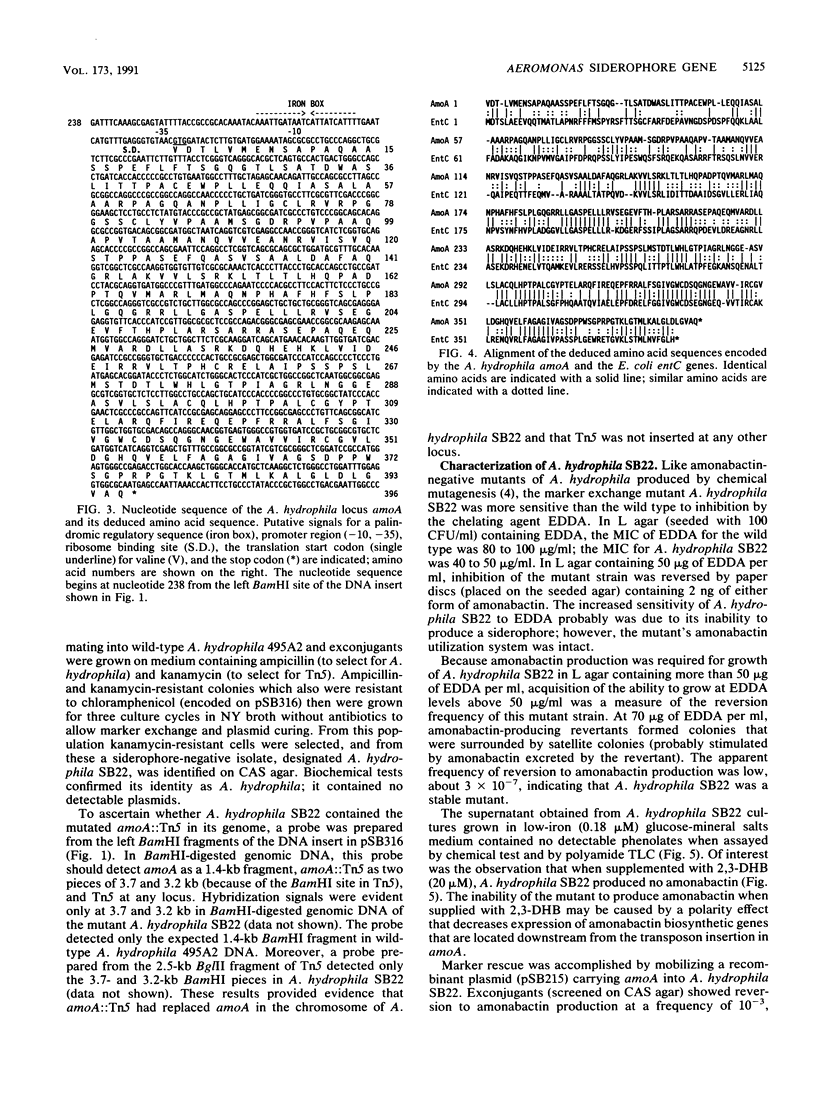
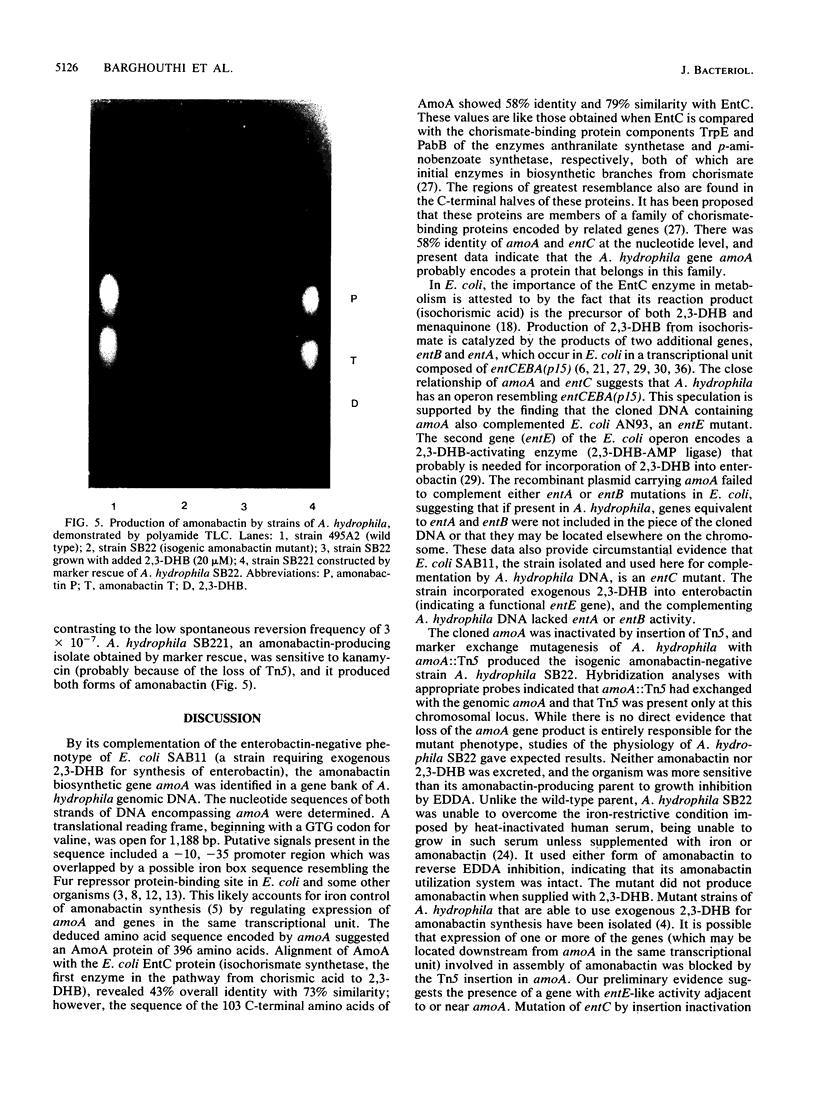
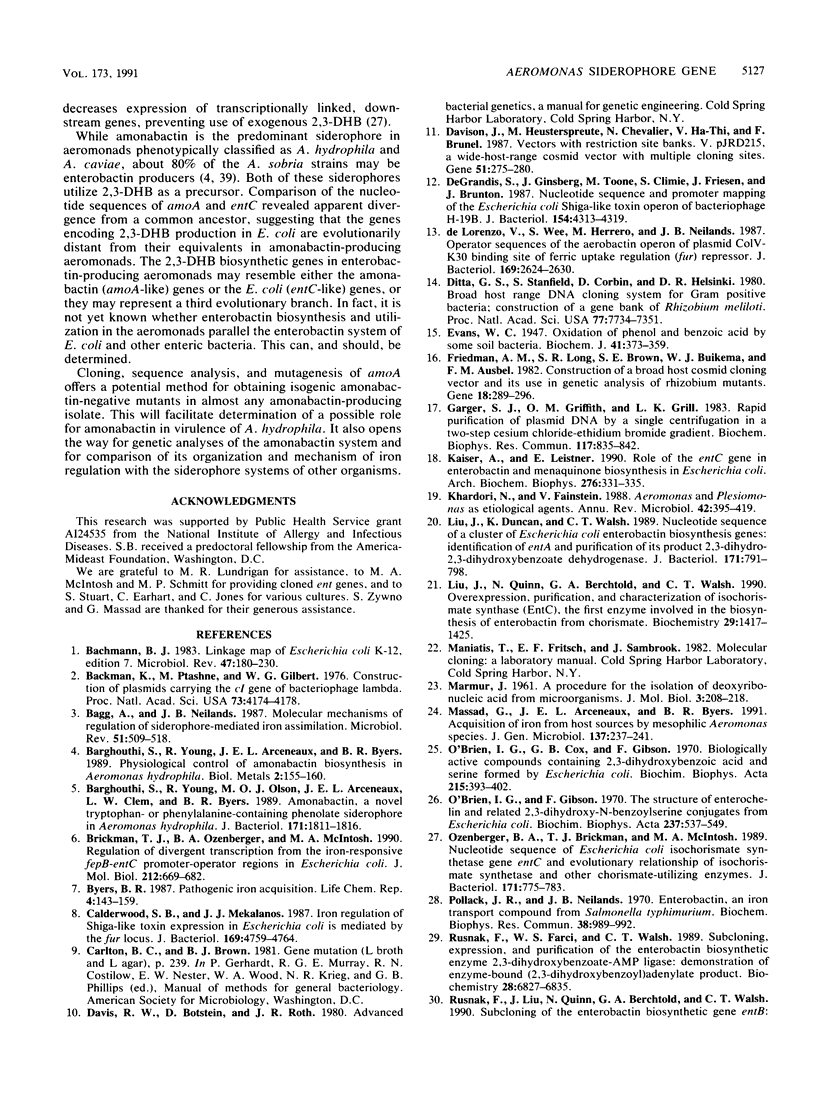
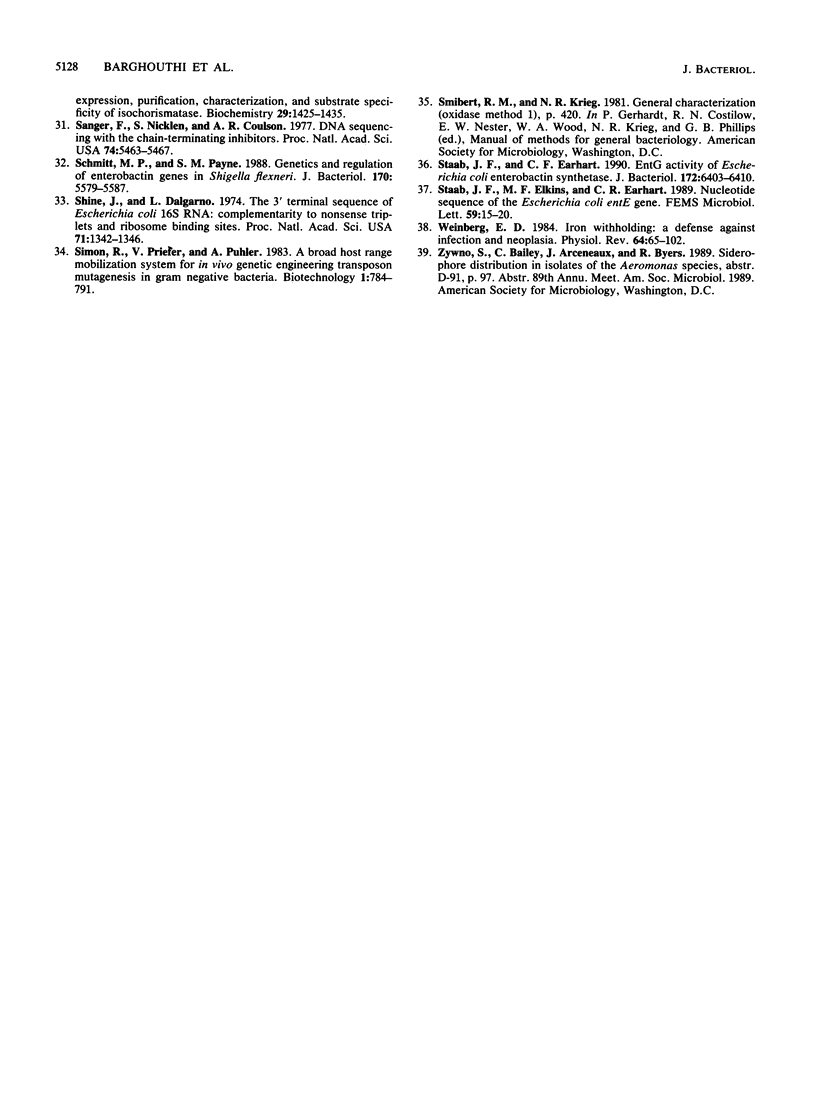
Images in this article
Selected References
These references are in PubMed. This may not be the complete list of references from this article.
- Bachmann B. J. Linkage map of Escherichia coli K-12, edition 7. Microbiol Rev. 1983 Jun;47(2):180–230. doi: 10.1128/mr.47.2.180-230.1983. [DOI] [PMC free article] [PubMed] [Google Scholar]
- Backman K., Ptashne M., Gilbert W. Construction of plasmids carrying the cI gene of bacteriophage lambda. Proc Natl Acad Sci U S A. 1976 Nov;73(11):4174–4178. doi: 10.1073/pnas.73.11.4174. [DOI] [PMC free article] [PubMed] [Google Scholar]
- Bagg A., Neilands J. B. Molecular mechanism of regulation of siderophore-mediated iron assimilation. Microbiol Rev. 1987 Dec;51(4):509–518. doi: 10.1128/mr.51.4.509-518.1987. [DOI] [PMC free article] [PubMed] [Google Scholar]
- Barghouthi S., Young R., Arceneaux J. E., Byers B. R. Physiological control of amonabactin biosynthesis in Aeromonas hydrophila. Biol Met. 1989;2(3):155–160. doi: 10.1007/BF01142554. [DOI] [PubMed] [Google Scholar]
- Barghouthi S., Young R., Olson M. O., Arceneaux J. E., Clem L. W., Byers B. R. Amonabactin, a novel tryptophan- or phenylalanine-containing phenolate siderophore in Aeromonas hydrophila. J Bacteriol. 1989 Apr;171(4):1811–1816. doi: 10.1128/jb.171.4.1811-1816.1989. [DOI] [PMC free article] [PubMed] [Google Scholar]
- Brickman T. J., Ozenberger B. A., McIntosh M. A. Regulation of divergent transcription from the iron-responsive fepB-entC promoter-operator regions in Escherichia coli. J Mol Biol. 1990 Apr 20;212(4):669–682. doi: 10.1016/0022-2836(90)90229-F. [DOI] [PubMed] [Google Scholar]
- Calderwood S. B., Mekalanos J. J. Iron regulation of Shiga-like toxin expression in Escherichia coli is mediated by the fur locus. J Bacteriol. 1987 Oct;169(10):4759–4764. doi: 10.1128/jb.169.10.4759-4764.1987. [DOI] [PMC free article] [PubMed] [Google Scholar]
- Davison J., Heusterspreute M., Chevalier N., Ha-Thi V., Brunel F. Vectors with restriction site banks. V. pJRD215, a wide-host-range cosmid vector with multiple cloning sites. Gene. 1987;51(2-3):275–280. doi: 10.1016/0378-1119(87)90316-7. [DOI] [PubMed] [Google Scholar]
- De Grandis S., Ginsberg J., Toone M., Climie S., Friesen J., Brunton J. Nucleotide sequence and promoter mapping of the Escherichia coli Shiga-like toxin operon of bacteriophage H-19B. J Bacteriol. 1987 Sep;169(9):4313–4319. doi: 10.1128/jb.169.9.4313-4319.1987. [DOI] [PMC free article] [PubMed] [Google Scholar]
- Ditta G., Stanfield S., Corbin D., Helinski D. R. Broad host range DNA cloning system for gram-negative bacteria: construction of a gene bank of Rhizobium meliloti. Proc Natl Acad Sci U S A. 1980 Dec;77(12):7347–7351. doi: 10.1073/pnas.77.12.7347. [DOI] [PMC free article] [PubMed] [Google Scholar]
- Evans W. C. Oxidation of phenol and benzoic acid by some soil bacteria. Biochem J. 1947;41(3):373–382. doi: 10.1042/bj0410373. [DOI] [PMC free article] [PubMed] [Google Scholar]
- Friedman A. M., Long S. R., Brown S. E., Buikema W. J., Ausubel F. M. Construction of a broad host range cosmid cloning vector and its use in the genetic analysis of Rhizobium mutants. Gene. 1982 Jun;18(3):289–296. doi: 10.1016/0378-1119(82)90167-6. [DOI] [PubMed] [Google Scholar]
- Garger S. J., Griffith O. M., Grill L. K. Rapid purification of plasmid DNA by a single centrifugation in a two-step cesium chloride-ethidium bromide gradient. Biochem Biophys Res Commun. 1983 Dec 28;117(3):835–842. doi: 10.1016/0006-291x(83)91672-8. [DOI] [PubMed] [Google Scholar]
- Kaiser A., Leistner E. Role of the entC gene in enterobactin and menaquinone biosynthesis in Escherichia coli. Arch Biochem Biophys. 1990 Feb 1;276(2):331–335. doi: 10.1016/0003-9861(90)90728-h. [DOI] [PubMed] [Google Scholar]
- Khardori N., Fainstein V. Aeromonas and Plesiomonas as etiological agents. Annu Rev Microbiol. 1988;42:395–419. doi: 10.1146/annurev.mi.42.100188.002143. [DOI] [PubMed] [Google Scholar]
- Liu J., Duncan K., Walsh C. T. Nucleotide sequence of a cluster of Escherichia coli enterobactin biosynthesis genes: identification of entA and purification of its product 2,3-dihydro-2,3-dihydroxybenzoate dehydrogenase. J Bacteriol. 1989 Feb;171(2):791–798. doi: 10.1128/jb.171.2.791-798.1989. [DOI] [PMC free article] [PubMed] [Google Scholar]
- Liu J., Quinn N., Berchtold G. A., Walsh C. T. Overexpression, purification, and characterization of isochorismate synthase (EntC), the first enzyme involved in the biosynthesis of enterobactin from chorismate. Biochemistry. 1990 Feb 13;29(6):1417–1425. doi: 10.1021/bi00458a012. [DOI] [PubMed] [Google Scholar]
- Massad G., Arceneaux J. E., Byers B. R. Acquisition of iron from host sources by mesophilic Aeromonas species. J Gen Microbiol. 1991 Feb;137(2):237–241. doi: 10.1099/00221287-137-2-237. [DOI] [PubMed] [Google Scholar]
- O'Brien I. G., Gibson F. The structure of enterochelin and related 2,3-dihydroxy-N-benzoylserine conjugates from Escherichia coli. Biochim Biophys Acta. 1970 Aug 14;215(2):393–402. doi: 10.1016/0304-4165(70)90038-3. [DOI] [PubMed] [Google Scholar]
- Ozenberger B. A., Brickman T. J., McIntosh M. A. Nucleotide sequence of Escherichia coli isochorismate synthetase gene entC and evolutionary relationship of isochorismate synthetase and other chorismate-utilizing enzymes. J Bacteriol. 1989 Feb;171(2):775–783. doi: 10.1128/jb.171.2.775-783.1989. [DOI] [PMC free article] [PubMed] [Google Scholar]
- Pollack J. R., Neilands J. B. Enterobactin, an iron transport compound from Salmonella typhimurium. Biochem Biophys Res Commun. 1970 Mar 12;38(5):989–992. doi: 10.1016/0006-291x(70)90819-3. [DOI] [PubMed] [Google Scholar]
- Rusnak F., Faraci W. S., Walsh C. T. Subcloning, expression, and purification of the enterobactin biosynthetic enzyme 2,3-dihydroxybenzoate-AMP ligase: demonstration of enzyme-bound (2,3-dihydroxybenzoyl)adenylate product. Biochemistry. 1989 Aug 22;28(17):6827–6835. doi: 10.1021/bi00443a008. [DOI] [PubMed] [Google Scholar]
- Sanger F., Nicklen S., Coulson A. R. DNA sequencing with chain-terminating inhibitors. Proc Natl Acad Sci U S A. 1977 Dec;74(12):5463–5467. doi: 10.1073/pnas.74.12.5463. [DOI] [PMC free article] [PubMed] [Google Scholar]
- Schmitt M. P., Payne S. M. Genetics and regulation of enterobactin genes in Shigella flexneri. J Bacteriol. 1988 Dec;170(12):5579–5587. doi: 10.1128/jb.170.12.5579-5587.1988. [DOI] [PMC free article] [PubMed] [Google Scholar]
- Shine J., Dalgarno L. The 3'-terminal sequence of Escherichia coli 16S ribosomal RNA: complementarity to nonsense triplets and ribosome binding sites. Proc Natl Acad Sci U S A. 1974 Apr;71(4):1342–1346. doi: 10.1073/pnas.71.4.1342. [DOI] [PMC free article] [PubMed] [Google Scholar]
- Staab J. F., Earhart C. F. EntG activity of Escherichia coli enterobactin synthetase. J Bacteriol. 1990 Nov;172(11):6403–6410. doi: 10.1128/jb.172.11.6403-6410.1990. [DOI] [PMC free article] [PubMed] [Google Scholar]
- Staab J. F., Elkins M. F., Earhart C. F. Nucleotide sequence of the Escherichia coli entE gene. FEMS Microbiol Lett. 1989 May;50(1-2):15–19. doi: 10.1016/0378-1097(89)90450-3. [DOI] [PubMed] [Google Scholar]
- Weinberg E. D. Iron withholding: a defense against infection and neoplasia. Physiol Rev. 1984 Jan;64(1):65–102. doi: 10.1152/physrev.1984.64.1.65. [DOI] [PubMed] [Google Scholar]
- de Lorenzo V., Wee S., Herrero M., Neilands J. B. Operator sequences of the aerobactin operon of plasmid ColV-K30 binding the ferric uptake regulation (fur) repressor. J Bacteriol. 1987 Jun;169(6):2624–2630. doi: 10.1128/jb.169.6.2624-2630.1987. [DOI] [PMC free article] [PubMed] [Google Scholar]



